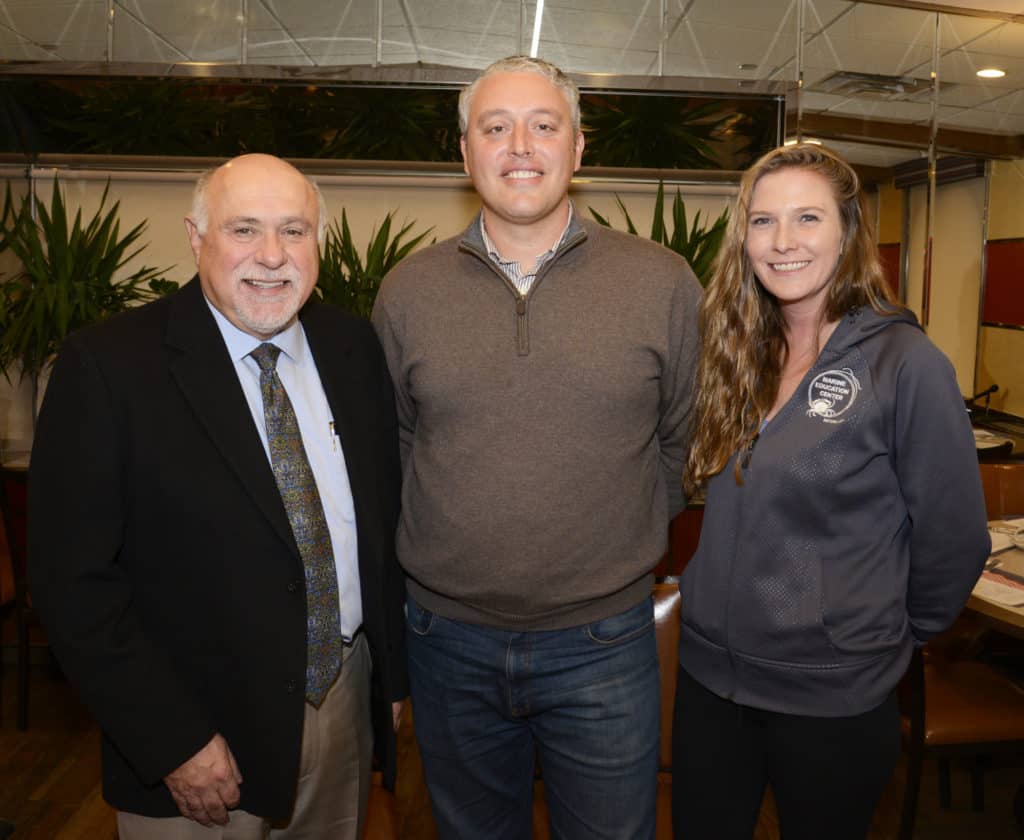
By Nina Recio
The Local Summit of Larchmont/Mamaroneck dedicated its Nov. 12 breakfast meeting to a panel discussion of ways to protect and restore the Long Island Sound, a jewel for those communities that share its shoreline.
Panelists Peter Linderoth, water quality program manager of the Connecticut Fund for the Environment/Save the Sound; Kyle Troy, a naturalist for Mamaroneck Harbor Island Park Marine Education Center; and Steve Altieri administrator of the Town of Mamaroneck, described the efforts – singular and collaborative – being undertaken by local governments, not-for-profits and concerned citizens to protect and promote a healthy Long Island Sound.
The Long Island Sound is surrounded by a densely populated land mass that presents challenges to its water quality. Altieri focused on storm water and local efforts to mitigate run-off. He explained that Mamaroneck Town joined with the villages of Larchmont and Pelham Manor, and the City of New Rochelle, to form a local consortium to attack inflow and infiltration by storm water.
During the summer, the consortium worked with the Westchester County Department of Environmental Conservation on a large joint project to evaluate the municipalities’ sewer systems. The evaluation disclosed 10,000 defects. Excavation and repair work commenced over the summer and should be completed in June. The repairs should eliminate about half of the inflow and infiltration issues, said Altieri.
He explained that during a typical storm, 1.6 million gallons of additional water flow into the treatment plants. As an example of some of the methods used to address the problem, Altieri described the recent renovation of the Town Center parking lot.
On a moderate rain day, prior to the renovation, approximately 700,000 gallons of water would run off the lot. Using grant money from the National Fish and Wildlife Foundation, the town undertook “green infrastructure” improvements, including installing porous pavement on the parking lot and permeable pavers on formerly-impervious concrete sidewalks, as well as creating two rain gardens that capture water and have a bio-retention filter to remove contaminants.
Approximately 148,000 gallons of water have been treated in the rain gardens.
The town also installed filters in the catch basins to capture any “particulates” that flow into the drains. These efforts have dramatically reduced water run-off, said Altieri.
Troy has been a field biologist for 14 years and was recently awarded the 2019 Marine Educator of the Year Award by the National Marine Educators Association. She is committed to working with students – the “future stewards of the Sound” – and described her work heading the Harbor Island Marine Education Center.
In addition to running summer programs for students, Troy works on programs with local schools and scouting troops and conducts weekly beach clean-ups. On a recent clean-up with a local environmental science class, the students collected 25 pounds of debris in one hour. The garbage included plastic cups, plastic bottles and caps, cigarette butts, and syringes (which require added precautions during the clean-up). The center also houses several tanks of species from the Sound, including a touch tank.
Troy is currently fundraising for a shark tank. She is also developing, with Eagle Scouts, floating wetlands and is working on oyster restoration.
The Marine Education Building is open from April to November.
Linderoth, who grew up on the Sound, explained to attendees that the two largest threats to the Sound’s health are nitrogen and bacteria. On the “open water” of the Sound, nitrogen poses the largest problem and can lead to oxygen deficiency, harming marine life, he said. Excess nutrients (mainly nitrogen and phosphorus) can result in fish kills, which he reports are now infrequent. The nitrogen mostly results from wastewater treatment plants.
Closer to the shoreline, the nitrogen problem appears to be more closely linked to stormwater run-off, according to Linderoth.
At the inlets and harbors, where the major threat is bacteria – mostly fecal bacteria – the source is largely affected human activities such as wastewater disposal, septic systems and the use of fertilizers.
Linderoth described the work of the Save the Sounds water quality department, whose employees and others work in the field collecting data from 63 locations in Greenwich, Westchester and Queens. It identifies “hot spots” and shares the information with local municipalities so they can locate the sources of contamination.
Linderoth also oversees the Unified Water Study, a program designed to collect water quality data from inlets and harbors in a uniform fashion for improved analysis.
The Larchmont/Mamaroneck Local Summit is an informal community council that seeks to make life better for all in the tri-municipal area. Its monthly meetings are held at the Nautilus Diner in Mamaroneck at 7:45 a.m., generally on the second Tuesday of the month. County Executive George Latimer will be the speaker at the next breakfast, Tuesday, Dec. 10.





